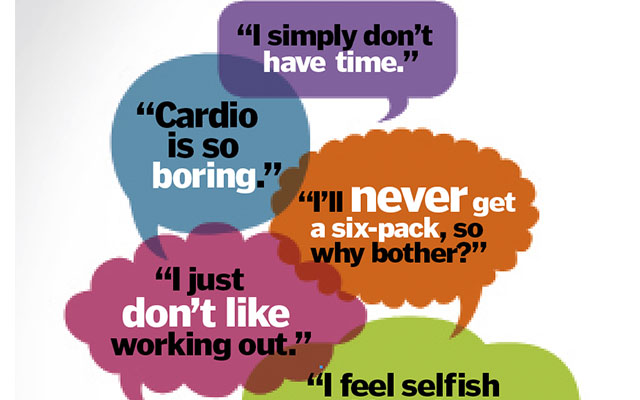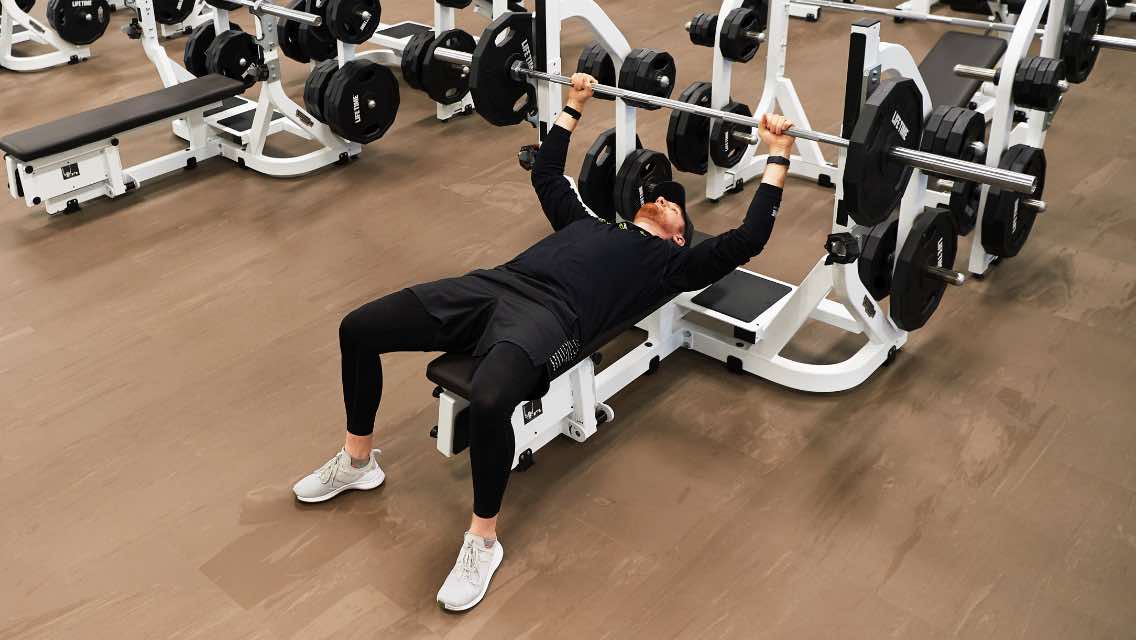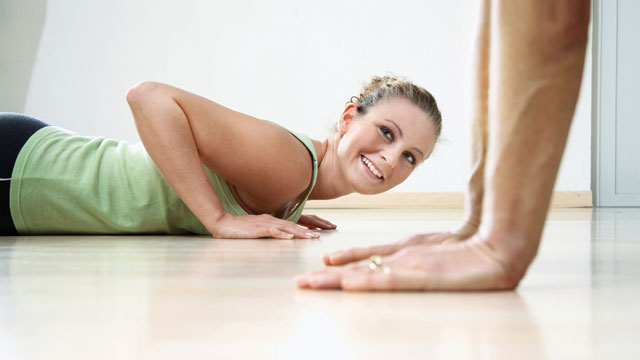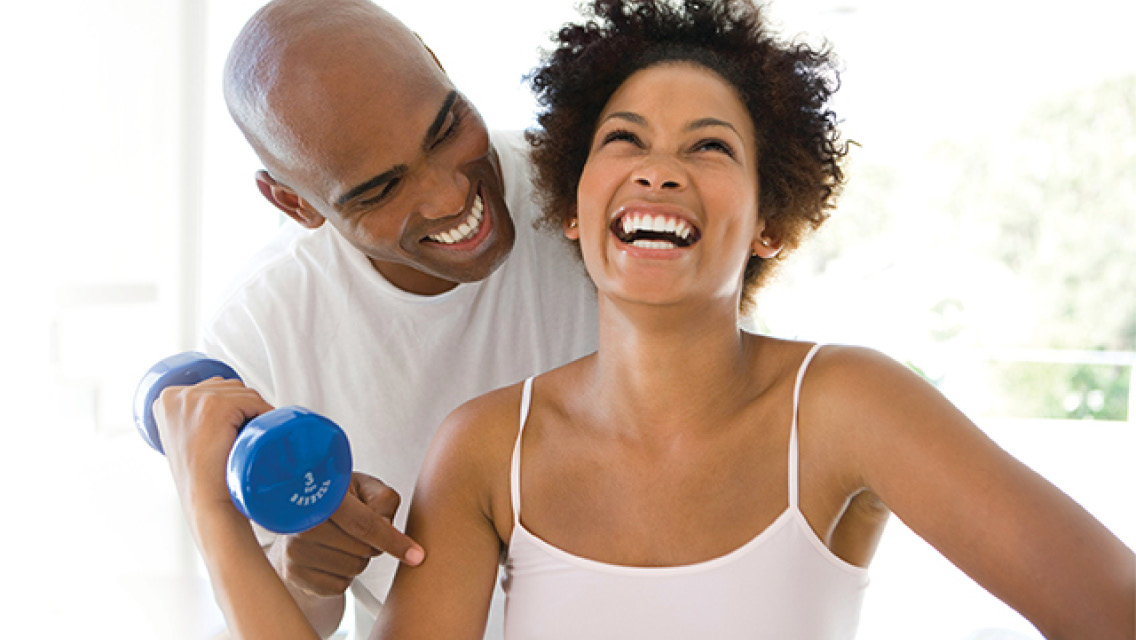What’s your excuse?:
No Time | It’s Boring | I’m Not [_____] | I Have an Injury | I Feel Awkward in Yoga | I Won’t Get a Six-Pack | Too Tired | Illness | I Just Don’t Like It | I Don’t Know How | It’s Selfish | No Childcare | I Hate Working Out Alone | I Don’t Like Other People Around | I Can’t Afford Training | Locker-Room Dread | No Motivation
We all know we’re supposed to exercise. There are so many good reasons! More strength and stamina. More energy. A sleeker, leaner physique. A longer, happier life.
And yet, when the alarm goes off for that early-morning run, or quitting time rolls around and kickboxing class beckons, it’s always easier to think of a reason not to go: No time. No childcare. No energy. No motivation.
Longtime exercisers know that the additional energy exercise provides makes it well worth the time and effort they expend — and that before long, that charged-up postworkout feeling can become a powerful motivator in itself.
So why do we let so many things — real-life obstacles as well as imagined excuses — get in our way?
“There are lots of reasons to not exercise — including social, cultural, financial, and time limitations,” says sports psychologist Michelle Cleere, PhD, author of From Here to There: A Simple Blueprint for Women to Achieve Peak Performance in Sports and Business. Still, she notes, “it’s what’s behind these reasons that really makes it hard to exercise: worries, doubt, fears, lack of confidence.”
None of us needs another sales pitch on the value of exercise. But we could all use more practical strategies on how to squeeze that workout in when it would be easier not to.
Here are 17 of the most common reasons people offer for bailing on their workouts — including lack of time and lack of confidence — and expert advice for overcoming them.
Don’t see your personal favorite excuse here? Leave it in the comments below.
“I just don’t have time.”
People sometimes assume that a workout has to happen in a certain place, at a certain time, and for a certain number of minutes in order to count. This isn’t true. “Some of the most fun training sessions my clients and I have done are under 30 minutes,” says fitness trainer Jen Comas Keck, NASM, cofounder of GirlsGoneStrong.com. “Set up a fast-paced circuit, keep your rest periods short, and you can get in and out in limited time.”
For days when you’re really pressed, keep gym clothes at work and a few pieces of equipment — a suspension trainer, some bands, a kettlebell or two — at home so you can squeeze in a workout even when you can’t make it to the gym. A 10-minute circuit (continuously rotating sets of, say, 10 pushups, 20 squats, and 12 lunges on each leg, resting minimally between sets) is far better than no workout at all.
“Cardio is so boring.”
Steady-state cardio can improve the health of your heart, and some people find it meditative and relaxing. But for many others, it’s a time-consuming, pain-inducing bore.
If you fall into the boredom camp, center your workouts on strength training, and add high-intensity, short-duration intervals for a cardio effect.
Sprints, jumping rope, kettlebell swings, and rope slams lend themselves well to high-intensity training. Build up to eight to 10 intervals of 30 to 45 seconds each, either between sets of other exercises in a strength workout, or with a 90-second rest between repetitions. Looking for more ideas? Check out “Three-Speed Cardio“.
“I’m not fit, strong, thin, or [fill in the blank] enough to go to the gym.”
If you’ve never set foot in a health club before, it’s easy to assume that they’re just for the über-fit. Take a walk-through during peak hours, however, and you’ll likely see a diverse cross-section of beginners, intermediates, and advanced exercisers, all building their fitness chops. And many of them had to overcome the exact same resistance to get there.
“Everyone at the gym is there to improve their health and feel better,” says Keck. “And we all have a right to be there.” So don’t get hung up on how you think you should be. Just make peace with where you are, and enjoy the journey.
So don’t get hung up on how you think you should be. Just make peace with where you are, and enjoy the journey.
It also pays to remember that we’re all a little self-focused, especially during our “me” time at the gym. “I can assure you nobody is paying attention to what you’re doing,” says Keck. “They’re too busy worrying about themselves!”
“I have an injury, so I shouldn’t exercise.”
While an injury is good reason to use caution, it doesn’t necessarily mean you have to curtail your workouts. “There’s always a way to exercise,” says Cleere.
Avoid anything that causes pain in the injured area, and do more of what you can do comfortably. When you have lower-back pain, you’re usually best off avoiding movements where you twist, bend to the side, or load the spine significantly — including heavy lower-body moves like squats and deadlifts. (Seeking advice on dealing with back issues? See “Back in Trouble“.)
If you have painful knees, skip exercises requiring your quads to do lots of work (such as lunges and leg extensions) and double down on hip-extension moves like Swiss-ball leg curls. Cranky shoulders? Don’t press anything overhead or in front of you, and focus on back exercises, particularly rowing, instead.
For acute injuries, Billy Anderson, Master Personal Trainer at Life Time Fitness in Eden Prairie, Minn., advises clients to simply “accept the limitation” and move on. Even if you have a sprained ankle, he points out, you can still do exercises for your upper body and the noninjured leg. If your physician clears you for activity, you can work with a limited range of motion in the injured area and gradually increase it as your symptoms improve. In most cases, a moderate amount of safe movement aids in recovery and reduces discomfort.
“I feel awkward in yoga class.”
The prospect of lunging, twisting, and downward-dogging in a room full of strangers can intimidate even the most enthusiastic of would-be yoginis. To make your initiation into the namaste crowd easier, Keck suggests, “find a beginner’s class, and set up your mat at the back of the room. You might also recruit a buddy to come along. Everything is a little less scary with a friend.”
Still gun-shy? Remember that yoga practitioners — newbies to experts alike — are rarely there to judge their fellow students. The culture of yoga is meant to be a gentle and accepting one. So go get your OM on.
“I’ll never get a six-pack so why bother?”
Images of shredded, flat-abbed fitness models are everywhere in popular media, but that aesthetic — often achieved through a combination of extreme dieting, short-term dehydration, and aggressive photo retouching — may not be a particularly realistic or worthwhile goal for most people.
Rather than focusing on achieving a particular appearance, set attainable fitness-oriented goals that reflect your current lifestyle and abilities.
Rather than focusing on achieving a particular appearance, set attainable fitness-oriented goals that reflect your current lifestyle and abilities. Focus less on how your body looks than on what it can do. Set your sights on the regular, daily actions you can pursue to become your healthiest, strongest, most body-confident self.
And remember, athletic bodies come in many shapes and sizes. Check out the differing physiques of competitive swimmers, marathoners, and weightlifters: They look entirely different, and yet each is at the pinnacle of fitness for his or her particular sport.
“I’m way too tired.”
Fatigue can be due to many factors. Chief among them are poor sleep and poor nutrition, which often play roles in the same vicious cycle.
“Study after study has shown that poor sleep adversely affects appetite and food intake,” says ISSA elite trainer Angelo Poli of Chico, Calif. Being short on shut-eye can make you hungrier for processed carbs and other foods of limited nutritional value, which can undermine your energy levels. This combination has a direct negative effect on your desire to exercise and the efficacy of your workouts — and can, in turn, create additional sleep disruptions.
Consider making sleep nonnegotiable. Set a bedtime you can stick to, and create rituals that help you unwind, such as taking a warm bath and setting aside electronic devices. If sleep still eludes you, talk to a medical practitioner about testing to rule out certain sleep disorders.
On the dietary front, eating too close to bedtime can lead to sleepless nights, as can choosing foods that are difficult to digest. Food intolerances can profoundly undermine your energy and make you feel chronically sleepy. Have a health professional evaluate your diet, if necessary, to determine if food might be the source of your fatigue.
“I’m sick.”
“If you have a fever or runny nose, or are otherwise in the acute stages of illness, stay out of the gym,” says Poli. “You’re likely to prolong your illness and may make someone else sick.”
Short of that, though, you’re probably OK to do at least a light workout when you’re under the weather. “Your aerobic capacity may be a little down, but lifting weights and light cardio are fine as long as you don’t go overboard,” he says.
Sometimes, the immune-system boost you receive from moderate exercise might even help you feel better. A 2009 study by University of Illinois researchers found that moderate exercise helped fight off viral respiratory infection better than either complete rest or intense exercise.
“I just don’t like working out.”
The first step to overcoming this obstacle is simply recognizing that our bodies were designed to move and to feel good in motion. Exercise can and should be fun. In fact, for an exercise plan to be effective and sustainable, it has to be enjoyable.
Once you’re open to that possibility, the next step is to figure out what’s fun for you.
Some people love to run and lift heavy weights, while others prefer Rollerblading and trapeze classes. Open your mind to nontraditional activities — such as a half hour at the trampoline park or playing kickball on a rec league — and you may discover an activity that gets your heart rate up and puts a smile on your face.
The key to finding your passion is trial and error. You can test-drive many activities for little cost by dropping in at your local gym or fitness studio (many offer free introductory classes) or by renting a bike, paddleboard, snowshoes, or other equipment for a small fee at your local park.
Discover activities you love, and you’re much more likely to stick to them.
“I don’t know how to exercise.”
Consider rewriting that statement: You don’t know how to exercise yet. In other words, you are learning. Which, by the way, is how everyone starts.
You can pull great workout ideas from magazines, books, and websites. You might also try fitness DVDs, which you can buy online or borrow from your local library, or hit YouTube for videos demonstrating key moves and form pointers.
If you’re a health-club member, consider trying out a group fitness class, or enlist a trainer to help you learn some basics. Adopt a beginner’s mind: Decide not to be intimidated by what you don’t yet know. Just start where you are, and over time you’ll gain both skill and confidence.
“I feel selfish taking time out for myself.”
Let go of your guilt. First, the few hours you invest in your workouts will help you show up as a better, healthier, more energetic parent. Second, being a regular exerciser with the discipline to carry out a self-care plan makes you a far better role model for your kids to look up to — and quite possibly a nicer parent to be around.
“I don’t have childcare.”
Get strategic. If you have a partner, the two of you can set up a schedule that lets you swap exercise and parenting stints. No dice? See if you can find another parent who wants to trade an hour or so of babysitting for “me time.” This arrangement has the added advantage of breaking up the day-to-day routine of caring for a young child and giving kids some social time with children their own age.
Increasingly, health clubs offer onsite childcare — and even activity classes for kids — either as part of your membership or for a nominal fee. If you’re a gym-goer, check your options at the front desk. And if your gym doesn’t offer these services, consider switching to another facility.
Another workaround is to exercise with your kids. If you have small children, tuck them into a jogging stroller and head out for a walk or run. At the park or playground, create a circuit that you can do while your kids play: pushups and step-ups on a park bench, pull-ups on the monkey bars, sprints across the length of the field. Or try a game of tag with your kids. This way, everyone gets a workout, and you’ll help instill good habits that will last your kids a lifetime.
“I hate working out alone.”
Find a workout buddy, preferably someone who has similar goals and taste in fitness activities. Enlist a friend, or work through a social group such as Meetup.com. You can also join an exercise class, where high-energy instructors provide guidance on workout techniques, and the group atmosphere keeps you motivated.
“I don’t like working out in front of other people.”
Make a point of seeking out environments where you have enough privacy to feel comfortable. Dance, lift, or do calisthenics in your living room. Bike some quiet park trails. Or hit the gym during off-peak hours.
And on the occasions when you just can’t seem to escape the madding crowd, pop in your headphones (the universal symbol for “leave me alone”) and get lost in your favorite songs or a terrific audiobook.
Focus on yourself and your goals, and you’re less likely to be bothered by the presence of others.
“I can’t afford a personal trainer or fancy home-gym equipment.”
Weigh the relative costs of powering your exercise habit against the costs of being less fit and healthy than you want to be. Basic memberships at many clubs amount to less than a monthly cable (or daily latte) bill. If you work for a large company, you may get a fee discount, or your health insurance may give you a rebate for hitting the club regularly.
If a gym membership simply isn’t in the cards, there are plenty of other budget-friendly options out there. Running and walking require little investment beyond a pair of sneakers. Bodyweight exercises require no equipment at all, can be performed almost anywhere, and can be scaled to your goals and fitness level. Start with squats, lunges, and pushups. Add some squat jumps, jumping lunges, and plyo pushups for a cardio boost. Work in some burpees, mountain climbers, jumping jacks, and plank variations, and you’ve got the most affordable workout program around.
“I really dread locker rooms.”
Gyms offer locker rooms as a convenience to members who like to go right to work or a social engagement after they exercise. But you never have to set foot inside one if you don’t want to. Just go to the gym in your workout gear, lock all your valuables in your car, place your car key in a zippered pocket, and you’re off to the races. Afterward, motor home and shower there.
“I just can’t get motivated.”
If you’re stressed out, undernourished, or exhausted, it can be hard to summon the motivation for anything, workouts included. But if you have a specific resistance to activity, there may be a deeper issue, such as body-image or exercise-related anxiety, that’s holding you back.
It can help to get in touch with your bigger “why” — the reasons you care about getting healthier and fitter, or why you feel compelled to take better care of yourself in general.
Motivation is mostly a question of getting in touch with what you care about in life.
“Motivation is mostly a question of getting in touch with what you care about in life,” says Anderson, who, in addition to being a trainer, is also a leadership coach.
Your doctor may tell you to exercise to lower your blood pressure, for example, but until lowering blood pressure has meaning for you — because you want to stick around for your partner and kids, for example — the inspirational value of that objective will be limited.
It can also help to connect your fitness ambitions with bigger life goals, like being able to keep up with your kids, completing an active adventure, or showing up more fully for your work and relationships. From there, Anderson says, “the practice of fitness will become intimately connected with those reasons.” And accordingly, it will become much easier — and more rewarding — to embrace.




This Post Has 0 Comments